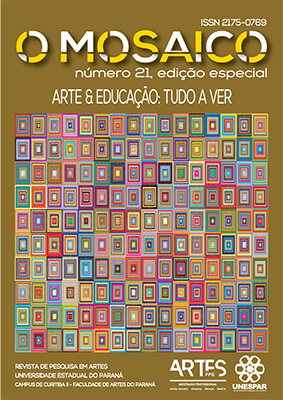SHEELA-NA-GIG: FEMINISMO ESTÉTICO ANCESTRAL E SEU REFLEXO NAS EXPRESSÕES ARTÍSTICAS CONTEMPORÂNEAS
DOI:
https://doi.org/10.33871/21750769.2021.13.2.4087Resumo
A ideia do Feminino muda no decorrer do tempo, inspira movimentos, conflitos, revoluções e tem muito a revelar sobre realidades socioculturais e políticas de um povo. O campo da arte traz numerosas representações dessas diferentes realidades e registros de narrativas persistentes como o binarismo, biopoder e sexualidades. As Sheela-na-gig, representações europeias medievais de genitais femininos em pedra, podem ser vistas como expressões da percepção do corpo feminino e do valor simbólico atribuído por povos medievais europeus. As peças em questão, produzidas por quatro séculos, conectam a cultura pagã e cristã e as fases históricas do pensamento ocidental no que se referem ao corpo, sexo, crenças e subjetividades. O presente artigo parte da análise destas imagens medievais até às expressões artísticas contemporâneas remetendo esta discussão à relevância da questão do Feminino nas atuais ressignificações de gênero.Downloads
Downloads
Publicado
Como Citar
Edição
Seção
Licença
Copyright (c) 2021 O Mosaico

Este trabalho está licenciado sob uma licença Creative Commons Attribution-NonCommercial-ShareAlike 4.0 International License.
Os autores detém os direitos autorais, ao licenciar sua produção na Revista O Mosaico/FAP, que está licenciada sob uma licença Creative Commons. Ao enviar o trabalho,e mediante o aceite, o autor cede seus direitos autorais para a publicação na revista. Osleitores podem transferir, imprimir e utilizar os artigos publicados na revista, desde que hajasempre menção explícita ao(s) autor (es) e à Revista O Mosaico/FAP não sendo permitidaqualquer alteração no trabalho original. Ao submeter um artigo à Revista O Mosaico/FAP e após seu aceite para publicação os autores permitem, sem remuneração, passar osseguintes direitos à Revista: os direitos de primeira edição e a autorização para que aequipe editorial repasse, conforme seu julgamento, esse artigo e seus meta dados aosserviços de indexação e referência.





